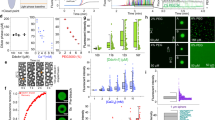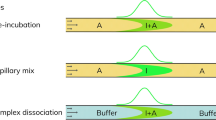Abstract
The free-state solution behaviors of drugs profoundly affect their properties. Therefore, it is critical to properly evaluate a drug’s unique multiphase equilibrium when in an aqueous enviroment, which can comprise lone molecules, self-associating aggregate states and solid phases. To date, the full range of nano-entities that drugs can adopt has been a largely unexplored phenomenon. This protocol describes how to monitor the solution behavior of drugs, revealing the nano-entities formed as a result of self-associations. The procedure begins with a simple NMR 1H assay, and depending on the observations, subsequent NMR dilution, NMR T2-CPMG (spin-spin relaxation Carr-Purcell-Meiboom-Gill) and NMR detergent assays are used to distinguish between the existence of fast-tumbling lone drug molecules, small drug aggregates and slow-tumbling colloids. Three orthogonal techniques (dynamic light scattering, transmission electron microscopy and confocal laser scanning microscopy) are also described that can be used to further characterize any large colloids. The protocol can take a non-specialist between minutes to a few hours; thus, libraries of compounds can be evaluated within days.
This is a preview of subscription content, access via your institution
Access options
Access Nature and 54 other Nature Portfolio journals
Get Nature+, our best-value online-access subscription
$29.99 / 30 days
cancel any time
Subscribe to this journal
Receive 12 print issues and online access
$259.00 per year
only $21.58 per issue
Buy this article
- Purchase on Springer Link
- Instant access to full article PDF
Prices may be subject to local taxes which are calculated during checkout










Similar content being viewed by others
Data availability
The NMR data that support Figs. 6–9 and Supplementary Figs. 1–5 are available in figshare (https://doi.org/10.6084/m9.figshare.15019755.v1).
References
LaPlante, S. R. et al. Monitoring drug self-aggregation and potential for promiscuity in off-target in vitro pharmacology screens by a practical nmr strategy. J. Med. Chem. 56, 7073–7083 (2013).
Duan, D. et al. Internal structure and preferential protein binding of colloidal aggregates. ACS Chem. Biol. 12, 282–290 (2017).
Feng, B. Y. & Shoichet, B. K. A detergent-based assay for the detection of promiscuous inhibitors. Nat. Protoc. 1, 550–553 (2006).
Feng, B. Y. et al. A high-throughput screen for aggregation-based inhibition in a large compound library. J. Med. Chem. 50, 2385–2390 (2007).
Owen, S. C., Doak, A. K., Wassam, P., Shoichet, M. S. & Shoichet, B. K. Colloidal aggregation affects the efficacy of anticancer drugs in cell culture. ACS Chem. Biol. 7, 1429–1435 (2012).
Dlim, M. M., Shahout, F. S., Khabir, M. K., Labonté, P. P. & Laplante, S. R. Revealing drug self-associations into nano-entities. ACS Omega 4, 8919–8925 (2019).
Ayotte, Y. et al. Exposing small-molecule nanoentities by a nuclear magnetic resonance relaxation assay. J. Med. Chem. 62, 7885–7896 (2019).
LaPlante, S. R. et al. Compound aggregation in drug discovery: implementing a practical NMR assay for medicinal chemists. J. Med. Chem. 56, 5142–5150 (2013).
Beaulieu, P. L. et al. Multi-parameter optimization of aza-follow-ups to BI 207524, a thumb pocket 1 HCV NS5B polymerase inhibitor. Part 2: impact of lipophilicity on promiscuity and in vivo toxicity. Bioorg. Med. Chem. Lett. 25, 1140–1145 (2015).
Owen, S. C. et al. Colloidal drug formulations can explain ‘bell-shaped’ concentration-response curves. ACS Chem. Biol. 9, 777–784 (2014).
Tres, F., Posada, M. M., Hall, S. D., Mohutsky, M. A. & Taylor, L. S. The effect of promiscuous aggregation on in vitro drug metabolism assays. Pharm. Res. 36, 1–9 (2019).
Ganesh, A. N. et al. Colloidal drug aggregate stability in high serum conditions and pharmacokinetic consequence. ACS Chem. Biol. 14, 751–757 (2019).
Frenkel, Y. V. et al. Concentration and pH dependent aggregation of hydrophobic drug molecules and relevance to oral bioavailability. J. Med. Chem. 48, 1974–1983 (2005).
Frenkel, Y. V., Gallicchio, E., Das, K., Levy, R. M. & Arnold, E. Molecular dynamics study of non-nucleoside reverse transcriptase inhibitor 4-[[4-[[4-[(E)-2-cyanoethenyl]-2,6-dimethylphenyl]amino]-2-pyrimidinyl]amino] benzonitrile (TMC278/rilpivirine) aggregates: correlation between amphiphilic properties of the drug and oral bioavailability. J. Med. Chem. 52, 5896–5905 (2009).
Ganesh, A. N., Donders, E. N., Shoichet, B. K. & Shoichet, M. S. Collodial aggregation: from screening nuisance to formulation nuance. Nano Today 19, 188–200 (2018).
Hoo, C. M., Starostin, N., West, P. & Mecartney, M. L. A comparison of atomic force microscopy (AFM) and dynamic light scattering (DLS) methods to characterize nanoparticle size distributions. J. Nanopart. Res. 10, 89–96 (2008).
Tomaszewska, E. et al. Detection limits of DLS and UV-Vis spectroscopy in characterization of polydisperse nanoparticles colloids. J. Nanomater. 2013, 313081 (2013).
Akoka, S., Barantin, L. & Trierweiler, M. Concentration measurement by proton NMR using the ERETIC method. Anal. Chem. 71, 2554–2557 (1999).
Seidler, J., McGovern, S. L., Doman, T. N. & Shoichet, B. K. Identification and prediction of promiscuous aggregating inhibitors among known drugs. J. Med. Chem. 46, 4477–4486 (2003).
Doak, A. K., Wille, H., Prusiner, S. B. & Shoichet, B. K. Colloid formation by drugs in simulated intestinal fluid. J. Med. Chem. 53, 4259–4265 (2010).
Hassan, P. A., Rana, S. & Verma, G. Making sense of Brownian motion: colloid characterization by dynamic light scattering. Langmuir 31, 3–12 (2015).
Ganesh, A. N., McLaughlin, C. K., Duan, D., Shoichet, B. K. & Shoichet, M. S. A new spin on antibody-drug conjugates: trastuzumab-fulvestrant colloidal drug aggregates target HER2-positive cells. ACS Appl. Mater. Interfaces 9, 12195–12202 (2017).
Wiest, J. et al. Geometrical and structural dynamics of imatinib within biorelevant colloids. Mol. Pharm. 15, 4470–4480 (2018).
Hong, Y., Lam, J. W. Y. & Tang, B. Z. Aggregation-induced emission. Chem. Soc. Rev. 40, 5361–5388 (2011).
Hong, Y., Lam, J. W. Y. & Tang, B. Z. Aggregation-induced emission: phenomenon, mechanism and applications. Chem. Comm. (29), 4332–4353 (2009).
Kestens, V., Bozatzidis, V., De Temmerman, P. J., Ramaye, Y. & Roebben, G. Validation of a particle tracking analysis method for the size determination of nano- and microparticles. J. Nanopart. Res. 19, 271 (2017).
Bevan, C. D. & Lloyd, R. S. A high-throughput screening method for the determination of aqueous drug solubility using laser nephelometry in microtiter plates. Anal. Chem. 72, 1781–1787 (2000).
Vom, A. et al. Detection and prevention of aggregation-based false positives in STD-NMR-based fragment screening. Aust. J. Chem. 66, 1518–1524 (2013).
Boulton, S. et al. Mechanisms of specific versus nonspecific interactions of aggregation-prone inhibitors and attenuators. J. Med. Chem. 62, 5063–5079 (2019).
Yang, Z. Y. et al. Structural analysis and identification of colloidal aggregators in drug discovery. J. Chem. Inf. Model. 59, 3714–3726 (2019).
Irwin, J. J. et al. An aggregation advisor for ligand discovery. J. Med. Chem. 58, 7076–7087 (2015).
Meiboom, S. & Gill, D. Modified spin-echo method for measuring nuclear relaxation times. Rev. Sci. Instrum. 29, 688–691 (1958).
Ryan, A. J., Gray, N. M., Lowe, P. N. & Chung, C. W. Effect of detergent on ‘promiscuous’ inhibitors. J. Med. Chem. 46, 3448–3451 (2003).
Feng, B. Y., Shelat, A., Doman, T. N., Guy, R. K. & Shoichet, B. K. High-throughput assays for promiscuous inhibitors. Nat. Chem. Biol. 1, 146–148 (2005).
Pellecchia, M., Sem, D. S. & Wüthrich, K. NMR in drug discovery. Nat. Rev. Drug Discov. 1, 211–219 (2002).
Hwang, J. & T., L. S. Water suppression that works. J. Magn. Reson. A 112, 275–279 (1995).
Acknowledgements
We thank the following agencies for helping fund this research: NSERC (Natural Sciences and Engineering Research Council of Canada), CQDM (Quebec Consortium for Drug Discovery), CFI (Canada Foundation for Innovation), Mitacs, INRS (Institut national de la recherche scientifique), Institut Pasteur, la région Auvergne-Rhône-Alpes, le ministère de l’enseignement supérieur et de la recherche (France) and NMX Research and Solutions Inc. We also thank our colleagues for their help, suggestions and encouragement: P. Bouchard, N. Girard, D. Bendahan, D. Girard, J. Tremblay and A. Nakamura.
Author information
Authors and Affiliations
Contributions
S.R.L.P. conceived the concepts described in this report. S.R.L.P. and V.R. wrote the paper. V.R., F.S., G.L.P., M.M.D., S.R.L.P., S.T.L., Y.A. and S.W. performed the experiments or helped with interpretations. Y.A. and S.T.L. implemented some of the experiments used herein.
Corresponding author
Ethics declarations
Competing interests
The authors declare no competing interests.
Additional information
Peer review information Nature Protocols thanks Ulrike Holzgrabe and the other, anonymous, reviewer(s) for their contribution to the peer review of this work.
Publisher’s note Springer Nature remains neutral with regard to jurisdictional claims in published maps and institutional affiliations.
Extended data
Extended Data Fig. 1 NMR 1H assay.
a, Preparation for assay in DMSO-d6. b, Preparation for assay in buffer. Shown are volumes suggested for 3-mm NMR tubes, and volumes for 5-mm tubes are in parentheses.
Extended Data Fig. 2 NMR T2-CPMG assay.
a, Preparation of the sample. b, Interpretation of the results.
Extended Data Fig. 3 Solvent solubility assay.
Preparation of the sample and interpretations.
Extended Data Fig. 4 Orthogonal assays.
a–c, Preparation of the samples for DLS (a), TEM (b) and CLSM (c).
Supplementary information
Supplementary Information
Supplementary Figs. 1–6 with discussions and Supplementary Tables 1–3.
Rights and permissions
About this article
Cite this article
LaPlante, S.R., Roux, V., Shahout, F. et al. Probing the free-state solution behavior of drugs and their tendencies to self-aggregate into nano-entities. Nat Protoc 16, 5250–5273 (2021). https://doi.org/10.1038/s41596-021-00612-3
Received:
Accepted:
Published:
Issue Date:
DOI: https://doi.org/10.1038/s41596-021-00612-3
Comments
By submitting a comment you agree to abide by our Terms and Community Guidelines. If you find something abusive or that does not comply with our terms or guidelines please flag it as inappropriate.



